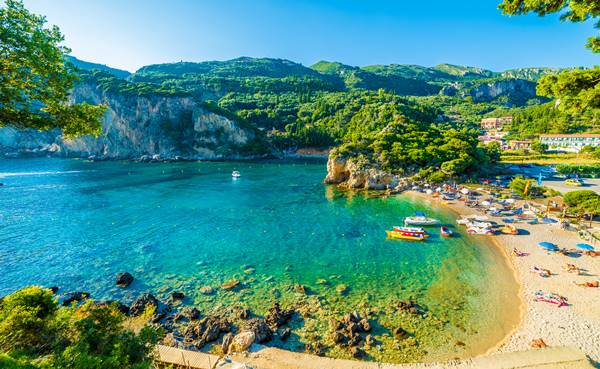Corfu, also known as Kerkyra, is a captivating island nestled in the azure waters of the Ionian Sea. Located off the northwest coast of mainland Greece, this enchanting destination offers a blend of history, natural beauty, and vibrant culture. Steeped in mythology and rich in ancient heritage, Corfu has been influenced by various civilizations throughout its history. The island boasts an impressive architectural legacy with Venetian fortresses, French-style mansions, and elegant British colonial buildings adorning its towns.

The charming Old Town of Corfu is a UNESCO World Heritage site and showcases narrow cobbled streets lined with colorful houses and quaint shops. Beyond its historical allure, Corfu offers idyllic sandy beaches framed by lush green landscapes and crystal-clear waters. From popular resorts to secluded coves, visitors can indulge in sun-soaked relaxation or partake in an array of water sports activities.
Historical Significance of Corfu Island
The historical significance of Corfu Island, Greece, is deeply rooted in its strategic location and rich cultural heritage. Throughout centuries, the island has been coveted and conquered by various civilizations, leaving behind a remarkable tapestry of influences.
Corfu’s history can be traced back to ancient times when it was settled by the Corinthians.
Later, it became a Roman province before falling under Byzantine rule.
The island was then occupied by the Venetians for over four centuries, resulting in an architectural blend of Venetian and Greek styles that still characterizes its old town today.
During the Napoleonic era, Corfu was briefly under French control before being ceded to the British Empire. This period witnessed significant urban development and political reforms that shaped modern Corfu.
Furthermore, Corfu’s strategic position in the Ionian Sea made it a crucial naval base throughout history. It served as a vital outpost during conflicts such as World War I and II.
Natural Beauty and Landscapes of Corfu Island
Corfu Island, boasts an enchanting natural beauty that captivates all who visit. From its rugged coastlines to its lush green hillsides, this Greek paradise offers a diverse range of landscapes. The island’s coastline is a treasure trove of stunning beaches and hidden coves. Golden sandy stretches like Paleokastritsa and Glyfada beckon sun-seekers, while secluded pebble beaches like Porto Timoni and Issos offer tranquility amidst dramatic cliffs.
Inland, Corfu reveals a verdant landscape dotted with olive groves, vineyards, and citrus orchards. The rolling hillsides are adorned with charming villages showcasing traditional architecture. Nature enthusiasts will find solace in Corfu’s rich biodiversity. The island is home to dense forests teeming with flora and fauna, such as cypress trees, wildflowers, and rare bird species.
Cultural Heritage and Traditions of Corfu Island
The cultural heritage and traditions of Corfu Island, are deeply rooted in its rich history and diverse influences. Known as the “Emerald Island,” Corfu has been shaped by various civilizations throughout the centuries. Its strategic position in the Ionian Sea has made it a coveted territory for many conquerors, leaving behind a mosaic of cultures. The island’s architecture reflects its past, with Venetian-style buildings adorned with intricate details and colorful facades.
The influence of the British occupation can also be seen in neoclassical structures scattered across the island. Corfu’s vibrant festivals and religious celebrations are essential aspects of its cultural fabric. The most famous event is Easter, where locals engage in solemn processions and joyful feasts. Music plays a vital role in Corfu’s traditions, with traditional bands performing during weddings and other social gatherings.
The island’s gastronomy is another significant part of its cultural heritage.
Popular Tourist Attractions in Corfu Island
Corfu Island, is a paradise for nature lovers and history enthusiasts alike. This enchanting island offers a plethora of popular tourist attractions that captivate visitors from around the world.
One must-visit destination in Corfu is the Old Town, a Unesco World Heritage Site. Its narrow streets are adorned with Venetian style buildings, elegant mansions, and charming squares. The imposing Old Fortress stands proudly at its entrance, providing panoramic views of the town and sea.
For those seeking natural beauty, Paleokastritsa is a must-see spot. This picturesque village boasts crystal-clear turquoise waters surrounded by lush green hills. Visitors can explore hidden caves by boat or enjoy sunbathing on golden sandy beaches.
Additionally, Achilleion Palace is another prominent attraction that showcases the island’s rich history and architectural grandeur.
Activities and Recreation on Corfu Island
Corfu Island, offers a plethora of activities and recreational opportunities for visitors to enjoy.
One of the most popular activities is exploring the island’s stunning beaches. With crystal-clear turquoise waters and golden sands, these beaches provide an ideal setting for swimming, sunbathing, and water sports such as snorkeling and jet skiing.
For those seeking adventure on land, Corfu boasts numerous hiking trails that traverse its lush green landscapes, offering breathtaking views of the coastline and mountains.
History enthusiasts can immerse themselves in the island’s rich cultural heritage by visiting historical landmarks like the Old Fortress and Achilleion Palace.
Additionally, exploring Corfu Town’s narrow streets lined with vibrant shops and traditional tavernas is a delightful way to experience local culture.
Nature lovers can venture into Corfu’s countryside to discover picturesque villages, olive groves, and vineyards.
Practical Information for Corfu Island Visitors
1. Getting there: Corfu Island is easily accessible by air, with Ioannis Kapodistrias International Airport serving as the main gateway. Numerous airlines offer direct flights from major European cities. Alternatively, you can reach the island by ferry from various Greek ports.
2. Transportation: Once on the island, public buses are a convenient and affordable way to explore Corfu’s towns and villages. Taxis are also available . Car rental services are widely available for those who prefer more freedom.
3. Currency and language: The official currency is the Euro (€), and most businesses accept major credit cards. While Greek is the native language, English is widely spoken in tourist areas.
4. Weather: Corfu enjoys a Mediterranean climate with hot summers and mild winters.